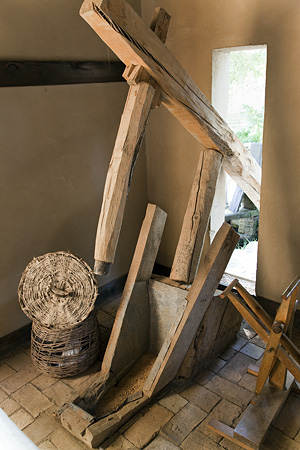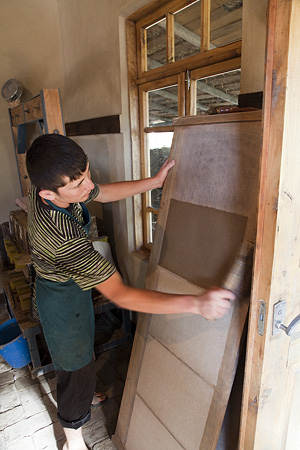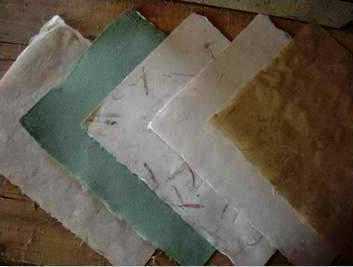 Today, in the 21 century, it is difficult to imagine the modern activity of humanity without paper. In spite of ultramodern IT-technologies, paper remains the main medium.
Today, in the 21 century, it is difficult to imagine the modern activity of humanity without paper. In spite of ultramodern IT-technologies, paper remains the main medium.
The famous historical fact is that paper was born in China. China held the monopoly for many centuries, keeping the secrets of its production. But the history points at the fact that paper was also produced in other countries.
In July, 751 on the river Taraz (Talas) the Chinese army invaded to the territory of Central Asia. But the ruler of Samarkand Abu Muslim directed his army against foreigners and captured twenty thousand of the Chinese. Among the Chinese soldiers there were many origins from craftsman families, including those who produced paper. Evidently, saving their lives they exposed all secrets of the technology to the local craftsmen. From this time, beginning from the VIII century, paper was produced in Samarkand, and at the beginning of the IX century the production of writing paper considered the important branch of workmanship.
During Amir Temur’s government the production of paper continued to be one of the main branches of workmanship. It is known that in latest time, at the beginning of the XVIII century, in Samarkand and its environs there were 42 workshops on paper producing. They were opened in Kokand, Bukhara and Tashkent. Cotton, silk and a rind of mulberry tree were used as basic material.
 Today the famous in the past Samarkand paper is produced on old formulas in a special built paper workshop in the village Konigil near Samarkand (at 10 km. from the center of Samarkand).
Today the famous in the past Samarkand paper is produced on old formulas in a special built paper workshop in the village Konigil near Samarkand (at 10 km. from the center of Samarkand).
The production mechanisms, as in the past, are operated with the help of the water wheel, using waters of the river Siab. Here, as many centuries ago, one can see the whole process of the famous Samarkand paper production on the ancient renewed technology.
Samarkand paper from the moment of appearance and till the end of the Middle Ages prevailed on the oriental and western markets. Different sorts of this products during one thousand of years, from VIII till XIX c. were famous not only in Central Asia, but in Middle East and Europe – Spain, France, Germany. The majority of Persian and Arabic manuscripts of the IX-X centuries were made on exactly Samarkand paper.
The technology of Samarkand paper producing is the following. The cuttings of two years branches of mulberry are soaked into water. The rind is peeled bast fibres are removed. Then the fibres are dried for the usage in winter or are put into the kettles. They are boiled in the kettles for 24 hours. After this they are pulverized in the mortar using the wooden pestle, which operates with the help of water from the aryk. The resulting intermediate product is filled with water, scoop up a screen in the form of a rectangular sheet of paper. At that time, as the water flows down, the pulp is shaken to mix the fibers. Wet leaves are placed under pressure, a day it is spread on smooth vertical surfaces, smoothing brush. Dried sheets have porous surfaces. To give the smoothness they are polished with shells. The natural color of Samarkand paper is light brown. For giving colors natural ink is used: juice of shokhtut - deep blue, juice of usma - green, onion peel - orange, indigo - blue, madder root - red, etc. Masters can decorate with the pressed flower petals.
 For thousands of years the masters from Samarkand developed the technologies of different kinds of paper producing: “Samarkand sulton kogozi” (Sultan sort). Paper was white, thin and soft. “Samarkand shoyi kogozi” (silk). Paper was also very smooth, thin, but had a light yellow color. “Mir-ibragim” had watermarks in white ring. And for producing “Nimkanop” sort (half hemp) the wastes of silk were mixed with bast fibres. The color turned out brown.
For thousands of years the masters from Samarkand developed the technologies of different kinds of paper producing: “Samarkand sulton kogozi” (Sultan sort). Paper was white, thin and soft. “Samarkand shoyi kogozi” (silk). Paper was also very smooth, thin, but had a light yellow color. “Mir-ibragim” had watermarks in white ring. And for producing “Nimkanop” sort (half hemp) the wastes of silk were mixed with bast fibres. The color turned out brown.
Now Uzbek miniaturists have an opportunity to create their masterpieces on paper, that was used by medieval authors. The products from the workshop from the village Konigil is also used in Japan while restoration of ancient manuscripts and in rarity publications. The examples of modern Samarkand paper are claimed in tourist industry of the country. Texts of menu, original souvenirs-boxes with rolls of Samarkand paper, different oriental masks, for example girls with small pigtails or smiling boys in national caps – all this is made in the workshop of Zarif Mukhtarov “Konigil-Meros”.
Art and techniques of Samarkand paper is becoming perfect every year. Diplomas and awards got in the international exhibitions, which were held in Kazakhstan, Holland and other countries are evident of it.
Tashkent city tour (1 d)
One day tour to Khiva from Tashkent (1 d)
Day tour to Samarkand from Tashkent (1 d)
Shakhrisabz tour from Samarkand (1 d)
One day tour to Bukhara from Tashkent (1 d)
Day trip & excursion to Chimgan Mountains (1 d)
One day tour to Termez (1 d)
One day tour to Chimgan Mountains (1 d)
Excursion to Muynak from Nukus (1 d)
Excursion to Solar Furnace from Tashkent (1 d)
Fergana valley tour from Tashkent (2 d)
2 days to Bukhara from Tashkent (2 d)
Samarkand and Bukhara tour (2 d)
"Afrosiyob" Speed Train Tour (3 d)
Kunya Urgench & Gas Crater Darvaza tour (2 d)
2-days trip to Samarkand (2 d)
Samarkand & Bukhara short tour (3 d)
Samarkand Tour from Tashkent (2 d)
Samarkand 2 day tour (2 d)
Samarkand 2 day tour (0 d)
Swimming session tour in Uzbekistan (0 d)
Nurata 3 days tour (3 d)
Marguzor tour from Samarkand (2 d)
Tamerlane Treasures Tour (2 d)
Aral Sea Tour: 3 days (3 d)
Mary Tour from Bukhara (2 d)
2 days tour to Ayaz Kala (2 d)
Penjikent – Khujand Tour (3 d)
Aral Sea Tour (2 d)
Darwaza – Ashgabat – Mary tour from Uzbekistan (3 d)
Short Turkmenistan Tour from Bukhara (4 d)
2 day Khujand Tour (2 d)
4 day Samarkand and Bukhara Tour (4 d)
Hush Kelibsiz or Welcome to Uzbekistan! (5 d)
Hello Uzbekistan (8 d)
In Ella Maillart’s steps (8 d)
Hello Uzbekistan (8 d)
Made in Uzbekistan! (6 d)
To Uzbekistan from Istanbul by Turkish Airlines (8 d)
Summer tour around Uzbekistan (9 d)
Blossoming gardens of Fergana Valley (6 d)
Grand Uzbekistan Tour (14 d)
Uzbekistan Group Tour 2024–2025 (8 d)
Uzbekistan 3-day tour (3 d)
Uzbekistan 4-day tour (4 d)
Uzbekistan 5-day tour (5 d)
Uzbekistan 6-day tour (6 d)
Uzbekistan 7-day tour (7 d)
Uzbekistan 8-day tour (8 d)
Uzbekistan 9-day tour (9 d)
Uzbekistan 10-day tour (10 d)
Uzbekistan 12-day tour (12 d)
Uzbekistan 14-day tour (14 d)
Uzbekistan 16-day tour (16 d)
Uzbekistan 3-day tour / 2 (3 d)
Asraf – Aydarkul Tour (4 d)
Turkey – Uzbekistan Grand Excursional Tour |1 (9 d)
Tour to Uzbekistan from Indonesia / Malaysia (7 d)
Uzbekistan tour from Malaysia / Singapore (7 d)
Winter Tale in Uzbekistan (from KL) (7 d)
Trip Uzbekistan from Mumbai 4 days (4 d)
Tour to Uzbekistan from India, Delhi| 1 (9 d)
Tour Uzbekistan from Delhi|2 (6 d)
Uzbekistan Tour from London, UK (7 d)
Uzbekistan Tour from NYC / USA (7 d)
Birdwatching tour in Uzbekistan (8 d)
7 day group tour on May holidays (7 d)
Gastronomic tour in Uzbekistan (8 d)
Birdwatching tour in Uzbekistan (9 d)
8 day Ethnic tour in Uzbekistan (8 d)
Uzbekistan winery tour (6 d)
8 day ceramic tour to Uzbekistan (8 d)
Ladies Only! Silk Road tour to Uzbekistan (7 d)
Uzbekistan Art Tour (8 d)
Wine tasting tour (7 d)
Aral Sea tour (9 d)
The the Aral Sea and beyond (2 d)
Trekking tour to Beldersay (3 d)
Aral Sea Tour (Extended) (3 d)
Aral Sea Tour (Basic) (2 d)
Aral Sea Tour - 4 (3 d)
Nurata Village Tour (3 d)
Nurata Hiking Tour (5 d)
Chimgan Hiking Tour (1 d)
Uzbekistan & TURKMENISTAN 9 days (9 d)
Uzbekistan & TURKMENISTAN 8 days (8 d)
Uzbekistan – Turkmenistan Tour | 3 (8 d)
Uzbekistan – Turkmenistan Tour | 1 (6 d)
Uzbekistan & TURKMENISTAN 10 days (10 d)
Uzbekistan-Turkmenistan Tour - 16 days (16 d)
Uzbekistan – Turkmenistan Tour | 7 (12 d)
Uzbekistan – Turkmenistan Tour | 6 (11 d)
Uzbekistan – Turkmenistan Tour | 4 (10 d)
11 days Uzbekistan & TAJIKISTAN tour (11 d)
9 day tour to Uzbekistan & Tajikistan (9 d)
12 day tour Uzbekistan - Tajikistan (12 d)
13 day tour Uzbekistan - Tajikistan (13 d)
Uzbekistan – Tajikistan Tour | 4 (11 d)
12/1 day tour Uzbekistan - Tajikistan (12 d)
9 day tour Uzbekistan - Tajikistan / 1 (9 d)
12/3 day tour Uzbekistan - Tajikistan (12 d)
Uzbekistan – Tajikistan Tour | 3 (10 d)
Uzbekistan – Tajikistan Tour | 1 (7 d)
Uzbekistan – Tajikistan Tour | 2 (8 d)
Uzbekistan – Tajikistan Tour | 5 (14 d)
15 day tour Uzbekistan - Tajikistan (15 d)
Uzbekistan – Turkmenistan – Kyrgyzstan 15 days (15 d)
Uzbekistan – Turkmenistan – Tajikistan 16 days (16 d)
Uzbekistan – Turkmenistan – Kyrgyzstan 18 days (18 d)
Kyrgyzstan – Uzbekistan – Tajikistan 16 days (16 d)
Uzbekistan – Kyrgyzstan – Kazakhstan 18 days (18 d)
Uzbekistan – Tajikistan – Turkmenistan 12 days (12 d)
Uzbekistan – Tajikistan – Turkmenistan 14 days (14 d)
Central Asia 4-stan tour - 2 (20 d)
Central Asia 4 STAN tour - 3 (14 d)
Central Asia 4 STAN tour - 4 (16 d)
Central Asia 4 STAN tour - 5 (12 d)
Central Asia 4-stan tour - 6 (16 d)
4 Stan Capital Tour (6 d)
Central Asia 4 STAN tour - 7 (22 d)
4-Stan Family Tour (15 d)
Central Asia 4 STAN tour - 8 (12 d)
Central Asia Summer Tour (20 d)
5-Stan Tour in Central Asia 1: 12 days (12 d)
5-Stan Tour in Central Asia 2: 14 days (14 d)
5 Stan tour in Central Asia 1: 14 days (14 d)
5-stan tour in Central Asia 4: 20 days (20 d)
5-stan tour in Central Asia 5: 24 days (24 d)
5 Stan Capital Tour (12 d)
5-stan tour in Central Asia 3: 18 days (18 d)
5-stan tour in Central Asia 7: 35 days (35 d)
5-Stan Family Tour: 20 days (20 d)
5-Stan Ethno Tour (40 d)
Central Asia tour. Turkmenistan - Uzbekistan (10 d)
Golf tour in Central Asia (11 d)
Uzbekistan and TURKMENISTAN Tour | 3 (11 d)
Combined tour around Turkmenistan and Uzbekistan for 15 days (15 d)
Combined tour around Turkmenistan and Uzbekistan for 12 days (12 d)
4 Stan tour (29 d)
4 stan tours (25 d)
Uzbekistan VIP Tour: 1 week itinerary (7 d)
Uzbekistan Silk Road Premium tour (5 d)
Central Asia VIP Tour (12 d)
5 STAN VIP TOUR (17 d)
Central Asian Pearls Premium (9 d)
4 STAN VIP Tour (17 d)
Copyright © 2008 - 2025 Anur Tour